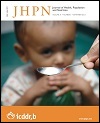Body Mass Index, Waist-circumference and Cardiovascular Disease Risk Factors in Iranian Adults: Isfahan Healthy Heart Program
DOI:
https://doi.org/10.3329/jhpn.v31i3.16831Keywords:
Body mass index, Diabetes mellitus, Dyslipidaemia, Hypertension, Obesity, Risk Factor, Waist-circumference, IranAbstract
Considering the main effect of obesity on chronic non-communicable diseases, this study was performed to assess the association between body mass index (BMI), waist-circumference (WC), cardiometabolic risk factors and to corroborate whether either or both BMI and WC are independently associated with the risk factors in a sample of Iranian adults. This cross-sectional study was performed on data from baseline survey of Isfahan Healthy Heart Program (IHHP). The study was done on 12,514 randomly-selected adults in Isfahan, Najafabad and Arak counties in 2000-2001. Ages of the subjects were recorded. Fasting blood glucose (FBG), 2-hour post-load glucose (2hpp), serum lipids, systolic and diastolic blood pressure (SBP and DBP), BMI, WC, smoking status, and total daily physical activity were determined. Increase in BMI and WC had a significant positive relation with the mean of FBG, 2hpp, SBP, DBP, serum lipids, except for HDL-C (p<0.001 for all). After adjustment for age, smoking, physical activity, socioeconomic status (SES), and BMI, the highest odds ratio (OR) (95% CI) for diabetes mellitus (DM) according to WC was 3.13 (1.93-5.08) and 1.99 (1.15-3.44) in women and men respectively. Moreover, the highest ORs based on BMI with adjustment for age, smoking, physical activity, SES, and WC were for dyslipidaemia (DLP) [1.97 (1.58-2.45) in women and 2.96 (2.41-3.63) in men]. The use of BMI or WC alone in the models caused to enhance all ORs. When both BMI and WC were entered in the model, the ORs for all risk factors, in men, according to BMI, were more compared to WC. However, in women, ORs for DM and hypertension (HTN) in WC quartiles were more than in BMI quartiles. BMI is the better predictor of DM, HTN, and DLP in men compared to WC. Conversely, in women, WC is a superior predictor than BMI, particularly for DM and HTN. Furthermore, the measurement of both WC and BMI in Iranian adults may be a better predictor of traditional risk factors of CVDs compared to BMI or WC alone.
DOI: http://dx.doi.org/10.3329/jhpn.v31i3.16831
J HEALTH POPUL NUTR 2013 Sep; 31(3): 388-397
Downloads
261
257

